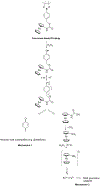Classification of Metal-based Drugs According to Their Mechanisms of Action
- PMID: 32864503
- PMCID: PMC7451962
- DOI: 10.1016/j.chempr.2019.10.013
Classification of Metal-based Drugs According to Their Mechanisms of Action
Abstract
Metal-based drugs and imaging agents are extensively used in the clinic for the treatment and diagnosis of cancers and a wide range of other diseases. The current clinical arsenal of compounds operate via a limited number of mechanisms, whereas new putative compounds explore alternative mechanisms of action, which could potentially bring new chemotherapeutic approaches into the clinic. In this review, metal-based drugs and imaging agents are characterized according to their primary mode of action and the key properties and features of each class of compounds are defined, wherever possible. A better understanding of the roles played by metal compounds at a mechanistic level will help to deliver new metal-based therapies to the clinic, by providing an alternative, targeted and rational approach, to supplement non-targeted screening of novel chemical entities for biological activity.
Figures





References
-
- Alessio E Bioinorganic Medicinal Chemistry; Wiley-VCH Verlag: Weinheim, 2011.
-
- Barry NPE; Sadler PJ (2013). Exploration of the medical periodic table: towards new targets. Chem. Commun 49, 5106–5131, and references therein. - PubMed
-
- Barry NPE; Sadler PJ (2014). 100 Years of Metal Coordination Chemistry: from Alfred Werner to Anticancer Metallodrugs. Pure & Applied Chem. 86, 1897–1910.
-
- Gasser G (2015). Metal Complexes and Medicine: A Successful Combination. Chimia 7, 442–446. - PubMed
Grants and funding
LinkOut - more resources
Full Text Sources
